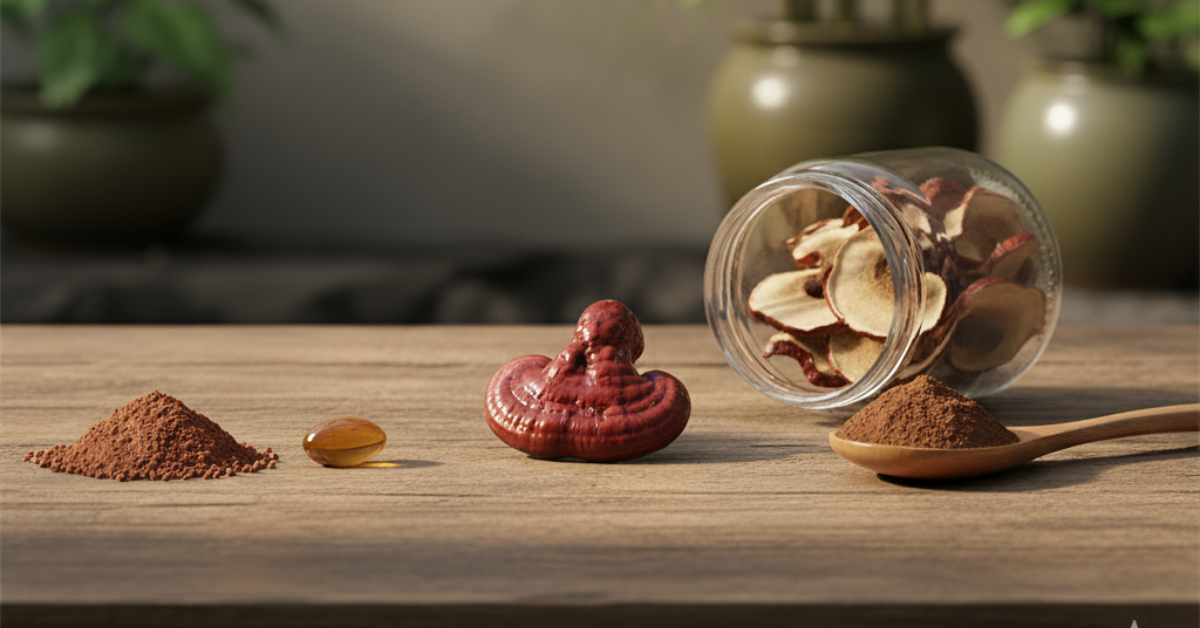Reishi mushroom (Ganoderma lucidum), often called the “mushroom of immortality,” has been used for centuries in Traditional Chinese Medicine to promote vitality, longevity, and resilience.
But what actually happens when you take Reishi every day for an extended period?
This guide walks you through the timeline of effects from your first two weeks to a full year of consistent use.
Rather than delivering a quick burst of energy like caffeine, Reishi works gradually to rebalance your system, enhance your immune response, reduce inflammation, and support deep, cellular-level health. Below is a month-by-month breakdown of the benefits you’ll likely notice, how your body will respond, and why these changes happen, with each effect grounded in science and powered by Reishi’s unique bioactive compounds.
After 2 Weeks
What You May Feel
- Slightly calmer mood, especially in the evenings
- Easier time falling asleep
- Fewer minor illnesses (e.g., sniffles or mild fatigue)
Why It Happens:
Reishi is rich in triterpenes, natural compounds that help reduce stress by gently lowering cortisol (your body's main stress hormone).
You may also feel a subtle lift in immunity because of β-glucans, complex sugars that begin training your immune system to respond more effectively to germs and viruses.
These initial benefits feel like a "smoothing out" of your system.
After 1 Month
What You May Feel:
- More restful, deeper sleep
- Reduced stress reactivity
- Improved digestion and less bloating
-
More stable energy throughout the day
Why It Happens:
Your nervous system is becoming more balanced. Triterpenoids in Reishi modulate receptors in the brain related to stress and anxiety, while polysaccharides begin to regulate gut function and liver detoxification. These effects combine to help with energy, digestion, and sleep. Reishi's antioxidants also start clearing oxidative waste from cells, promoting clarity and cellular repair.
After 3 Months
What You May Feel:
- Stronger immunity—you catch fewer colds
- Reduced joint stiffness and muscle soreness
- Healthier skin—less dryness or inflammation
-
Improved mental focus and emotional balance
Why It Happens:
At this point, Reishi’s immune-modulating powers are in full effect. β-glucans are enhancing the activity of T cells and natural killer cells, which fight infections. Meanwhile, ganoderic acids help lower inflammation throughout the body, easing joint pain and improving skin clarity. Reishi also nourishes the gut-brain axis, which enhances mood and focus through improved serotonin balance and reduced brain inflammation.
After 6 Months
What You May Feel:
- Consistent mental sharpness
- High resilience to stress
- Healthy blood pressure and cholesterol levels
-
More noticeable glow to the skin and eyes
Why It Happens:
Long-term Reishi use supports cardiovascular and cognitive health. Triterpenes gently inhibit ACE enzymes, naturally helping to regulate blood pressure. Reishi also boosts glutathione, the body's master antioxidant, which supports liver detox and healthy cholesterol. Ergosterol (a vitamin D precursor in Reishi) supports hormonal balance and enhances skin vitality. You feel more "put together" physically and mentally.
After 1 Year
What You May Feel:
-
High overall vitality and fewer sick days
-
Deep, sustained calm and emotional resilience
-
Clear, glowing skin and smooth digestion
-
“Lighter” feeling body with better recovery from stress or exertion
-
A noticeable difference in how you handle both mental and physical challenges
Why It Happens:
After a year, Reishi has fine-tuned your body’s internal systems:
- Immune system is better at distinguishing real threats from minor irritants
- Liver and kidneys are detoxing more efficiently, keeping your internal chemistry clean
-
Brain function is sharper due to reduced oxidative damage and better blood flow
- Hormones are better balanced, supporting mood, metabolism, and energy
Compounds like β-glucans, ganoderic acids, ergosterol, and trace minerals such as germanium and selenium work together to bring your body into long-term homeostasis, meaning your systems are operating in harmony. It’s not about a sudden jolt of energy—it’s about becoming more resilient, balanced, and aligned from the inside out.
References
-
Boh, B. et al. (2007). Ganoderma lucidum and its pharmaceutically active compounds. Biotechnology Annual Review, 13, 265–301.
-
Sanodiya, B. S. et al. (2009). Ganoderma lucidum: A potent pharmacological macrofungus. Current Pharmaceutical Biotechnology, 10(8), 717–742.
-
Wachtel-Galor, S., & Benzie, I.F.F. (2011). Ganoderma lucidum (Lingzhi), in Herbal Medicine: Biomolecular and Clinical Aspects. 2nd edition.
-
Zhou, X. et al. (2007). Ganodermataceae: Natural products and their related pharmacological functions. American Journal of Chinese Medicine, 35(4), 559–574.
-
Gao, Y. et al. (2003). Effects of Ganopoly® (a Ganoderma lucidum polysaccharide extract) on the immune functions in advanced-stage cancer patients. Immunological Investigations, 32(3), 201–215.
-
Yang, B.K. et al. (2000). Hypoglycemic effect of a crude exopolysaccharide isolated from a mutant strain of Ganoderma lucidum. Phytochemistry, 55(4), 367–371.
-
El-Mekkawy, S. et al. (1998). Anti-HIV activity of ganoderiol F, a triterpenoid from Ganoderma lucidum. Journal of Natural Products, 61(2), 1313–1315.
-
Paterson, R. R. M. (2006). Ganoderma – a therapeutic fungal biofactory. Phytochemistry, 67(18), 1985–2001.
- Chang, S.T. & Buswell, J.A. (1999). Ganoderma lucidum (Curt.: Fr.) P. Karst. (Ling Zhi) in China: biology, cultivation, and traditional herbal use. International Journal of Medicinal Mushrooms, 1(4), 263–282.
- Kim, G. Y. et al. (2006). Ganoderma lucidum suppresses inflammatory responses by modulating the NF-κB and MAPK signaling pathways in LPS-stimulated BV2 microglial cells. Journal of Ethnopharmacology, 111(3), 586–592.





